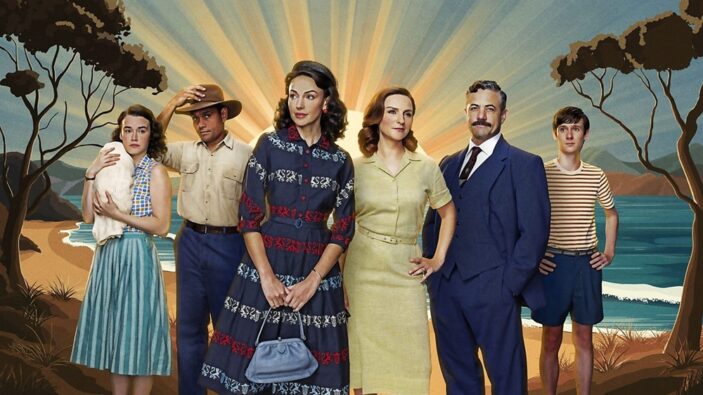
Having made it to Australia in season one, the characters of Stan and BBC One’s collaborative historical drama series Ten Pound Poms find themselves faced with even more stark realities about their new life as the show returns for a second season. While each of the core characters came to the camp at Galgownie in New South Wales (a fictional Migrant Workers Hostel, potentially based on Balgownie) expecting that Australia would be the land of plenty that they needed to turn their lives around, they found themselves living in close quarters, and often ostracised by the communities they were trying to join.
Season one focused on three storylines. There was that of the Roberts family, headed by Terry and Annie (Warren Brown and Faye Marsay, respectively) and their children Pattie and Peter; that of nurse Kate Thorne (Coronation Street‘s Michelle Keegan); and that of Sheila Anderson (Emma Hamilton), whose affair with Galgownie hostel manager, JJ (Stephen Curry), puts her at risk from her volatile (and corrupt) husband, Bill (Leon Ford). At the end of season one, our characters were left at a turning point, with the Roberts’ family reeling from the revelation that Pattie (Hattie Hook) was pregnant when she left Manchester, Kate on the run having abducted her son back from the family who adopted him after he was forcibly removed from her care and sent halfway across the world, and Sheila locked up in an institution, having been rescued from an attempt to take her own life. Meanwhile, JJ has been relieved of his command at Galgownie, with his mother (played by Prisoner alum Tina Bursill) stepping in to take charge.
Sheila and Bill’s story takes a step back for the second season, and a bigger focus is put on the younger members of the Roberts family, with Pattie embracing the challenges of motherhood and Peter facing the trials and tribulations of being a teenage boy, complete with his first crush on an older girl – the daughter of an Irish family who move in to Arty Farthington’s dilapidated death-trap of a cabin. (Remember him? The character who died right as he, Terry and Rob Collins’ Ron were about to start their fish and chip shop on the beach?). Pattie’s daughter Mary attracts a lot of attention, not only because her mother is so young, but because the child is mixed race, leading Pattie to rely on the support of boyfriend, Stevie. Pattie, a complicated young woman who feels more comfortable kicking a soccer ball around than flirting with boys, struggles with the idea that the life she envisioned for herself might be gone for good, but with the help of her family (okay, so it’s mostly Annie), overcomes every obstacle thrown her way.
Likewise, Annie supports Kate, who, upon realising that her son, Michael, does not remember her and truly loves his adoptive parents, surmises that running away with him and living happily every after might not be as simple as she’d thought. After the women hatch a plan to appeal to the motherly sensibilities of Fran Robinson, the boy’s adoptive mother, it then also falls to Annie to help Kate escape legal consequences when things take a turn. Her solution? Robbie Carter (Nic English), the dashing immigration photographer whom Kate charmed and then swindled in season one in order to steal the very file that helped her track Michael down in the first place. Robbie – who has been holding a torch for Kate all this time – agrees to pose as her fiancé in order to stop her deportation, and while Kate only agrees at first to continue in her single-minded quest to get her son back and expose the wrongdoings of the Catholic orphanage who sent him away to a new family without her consent, she soon finds herself falling for him for real, and must make the decision between giving up on her quest for justice, or pursuing a new chance to be happy. Thankfully, this season is devoid of Hugo Johnstone-Burt‘s character, Henry, whom Kate spent a lot of season one hiding from. I’m sorry, but Johnstone-Burt just has too kind and sweet of a demeanour to be a convincing villain, and will always be Constable Collins to me.
But what about Annie herself? Marsay is known for more edgy, gritty television, such as Game of Thrones and Black Mirror and has one of those faces that you know you’ve seen in lots of things even if you can’t place her. As Annie, she fits well into the category of long-suffering wife and mother with a secret sense of grit to her. She can move from dowdy and motherly to glamorous on the beach in a bikini, causing a scandal, with relative ease, and her performance seems to be the glue that holds this show together. Annie’s backstory is explored a little more in this season, and as she and Pattie bond over the fact that, yes, they’ve both made mistakes in love and lust, viewers might find that they respect her a whole lot more for what she’s chosen to put up with from her husband over the course of the show. Her burgeoning business partnership with the elegant Marlene (Cheree Cassidy) hints at what might be to come if the show continues, and given the changing fashions and social mores of the late 1950s and 1960s, this might prove fertile ground for more drama, particularly as she continues to explore her rebellious streak.
If you think that all sounds a bit like a soap opera, you’d be right! The high drama with a quick resolution format of the show makes it a light watch, though the show also touches on deep issues of racism and its links to immigration, as well as the gender and class politics of the period. Six episode arcs are not long enough to fully do these issues justice, and some of the subplots – including Terry’s job as an ‘enforcer’ to a dodgy landlord, and what Ron’s up to while the rest of this is going on – don’t always get the weight that they deserve. While some reviews have compared the show to things like Call the Midwife, I fear we won’t find ourselves with such a long-running drama over which to develop the characters or the storyline. Still, it’s refreshing to see Australian history brought to the screen, even with a few anachronisms, and the show is extremely watchable. The trio of leading ladies, Marsay, Keegan and, increasingly for season two, Hook, are compelling to watch and kept me hitting that ‘next episode’ button. You might even spot a few big name Australian guest stars (according to IMDb, the body in the casket in episode two is apparently played by Simon Baker but I didn’t get a close enough look). Though show-runner Daniel Brocklehurst is English, Ten Pound Poms is the second Stan program to land in 2025 featuring Australian stories and locations (the first being Invisible Boys.) Here’s hoping that this is the start of many shows that take an interest in Australian stories, and bring the past to life for a new generation of Australian viewers- even if there are a few anachronisms.
![]()
![]()
![]()
![]()
![]()
FOUR STARS (OUT OF FIVE)
All 6 episodes of Ten Pound Poms season 2 (plus all of season 1) are now available to stream on BBC iPlayer in the UK and on Stan in Australia.
